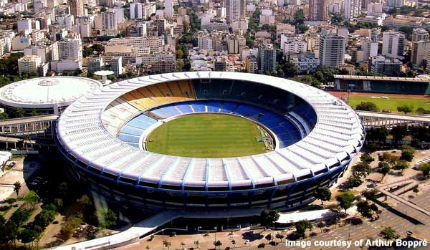
The Maracana is an open-air stadium in Rio De Janeiro, Brazil. Named after the Maracana region, the stadium was built in 1950. It has hosted numerous football matches, including the final of the 1950 FIFA World Cup.
The stadium is owned by the Government of Rio de Janeiro. The stadium, which is the largest in South America, underwent a comprehensive renovation programme ahead of the 2014 World Cup and the 2016 Olympics.
Empresa de Obras Públicas (EMOP) and Secretary of Works are the owners of the project. The renovation project started in August 2010 and was completed by May 2013.
The stadium was opened to public for tours in April 2012, although renovation works were still going on. The project cost approximately $500m.
Existing structure
The Maracana was originally built using reinforced concrete. It has an oval shape and consists of two tiers divided by medium-sized open boxes. A cantilevered roof spanning 30m covers 34 rows at the rear of the stadium.
After its 50th anniversary in 2000, the stadium was renovated to increase its full capacity to nearly 103,000. The stadium remained closed for nine months between 2005 and 2006. When it reopened in January 2007, the all-seated capacity was 87,000.
Renovation plan / design
The renovation focused on visibility, accessibility, safety and hospitality. While most of the stadium was reformed, the original blue facade and the rear space of the stadium was preserved. As per the recommendations of FIFA, the stadium’s capacity was reduced from the current 87,000 to 73,500. A roof to cover the entire public area was added to the five-storey stadium.
The renovation converted the Maracana into a multi-purpose arena complete with bars, restaurants and shops. To boost accessibility and security, four ramps were constructed. Two existing ramps are also being reused. The upgrade allows for full evacuation of the stadium within just eight minutes.
A new hospitality area was constructed on the west side of the ground floor. Intended for athletes, media and guests of FIFA, the area will be equipped with locker rooms. Four of the locker rooms are for athletes and referees. Rooms have direct access to the field. Part of the hospitality area has an auditorium. There is also a common meeting area for athletes.
Related project
Rio 2016 Olympic Park Master Plan, Barra de Tijuca, Brazil
Rio 2016 Olympic Park, situated in Barra de Tijuca, south-west of Rio de Janeiro in Brazil, will be where the main sports cluster of the 2016 Olympic and Paralympic Games is located.
The north side of the stadium is devoted to operational support services. The west side of the stadium’s top ring has 3,000 seats for the media. The area is connected to the hospitality section via a lift. Two floors feature 88 boxes, each measuring 50m² and with the capacity to accommodate up to 30 people. The boxes have an attached private grandstand.
The region’s northern area was also refurbished. The Celio de Barros Stadium, a neighbouring stadium often used for international competitions, is fitted with a 10ha centre for media and a 7,159m² broadcast compound. All the Maracana’s seats have been replaced.
Fans are placed close to the performance on the pitch at a distance of 14.4m from players. The renovated stadium uses solar energy for power supply. The roof top of the stadium +is fitted with 1,500 photovoltaic solar modules to produce solar energy.
Parking facilities
Under FIFA regulations the stadium requires 14,000 parking spaces. Almost 1,000 parking spaces have been constructed at the stadium. The remaining spaces are provided in adjacent areas, including the State University of Rio de Janeiro (UERJ), military colleges and army land.
Finance
The renovation was funded jointly by the National Bank for Economic Development (BNDES) and the State Government of Rio de Janeiro. BNDES provided 75% of the cost, with the remaining money sourced from the state government.
Contractors
The stadium reconstruction contract was awarded to Maracanã Rio 2014 Consortium which included Odebrecht Infraestrutura, Delta Construção and Andrade Gutierrez.
Delta Construção Company pulled out of the project in April 2012 following corruption allegations. Odebrecht Infrastructure and Andrade Gutierrez jointly took over the stake owned by Delta.
In April 2012, Otis was contracted to supply 21 elevators and escalators for the stadium.







